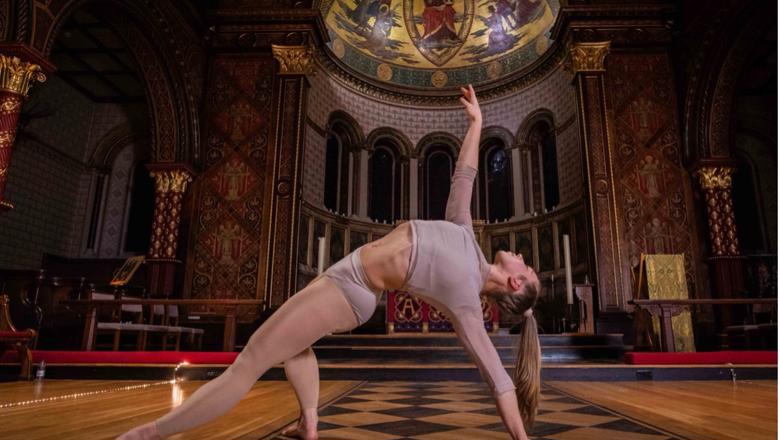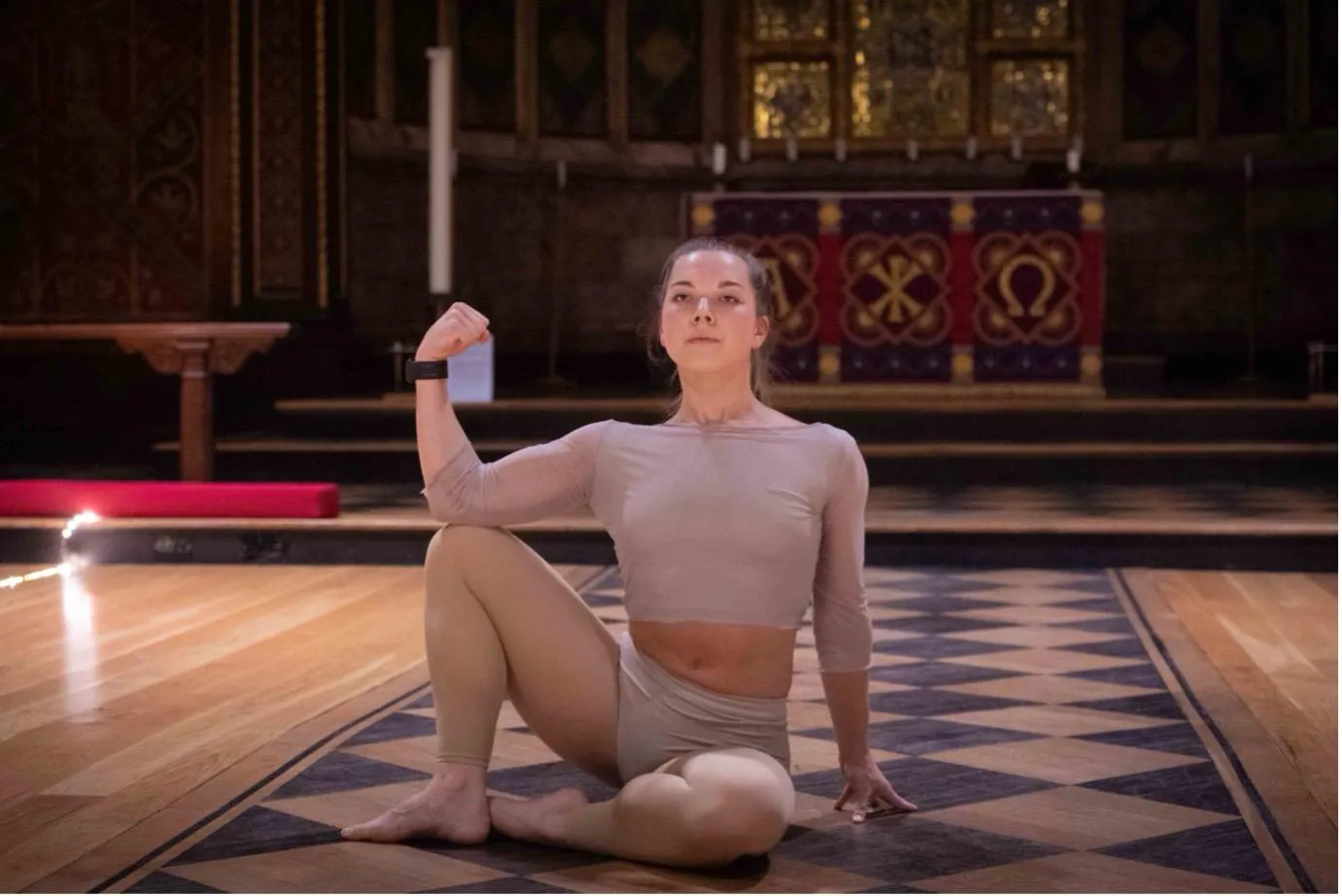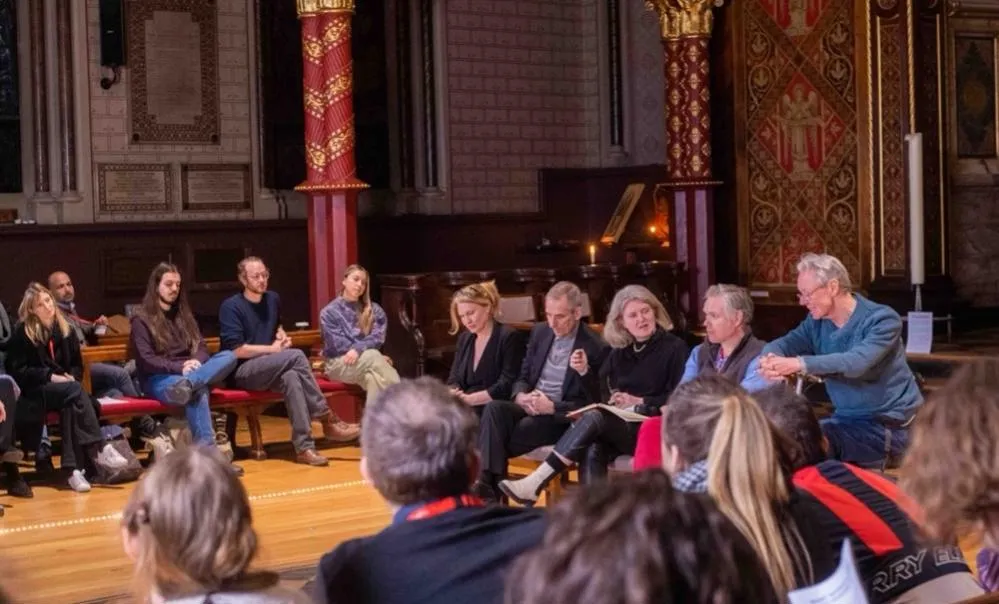This performance sits at the critical intersection of the arts and science, highlighting novel and important ways of viewing the body, the mind and human experience. It is a reminder that we are, even in in our pain and solitude, embodied beings – and that throughout history, technology has helped us communicate that to others.
Professor Fay Bound Alberti, Director of the Centre for Technology and the Body
23 January 2024
Pioneering dance performance explores 'living well with technology' at King's Chapel
Strand Campus played host to a dance performance with a difference in 'Feedback Loops' on 18 January.

King's Chapel showcased Feedback Loops, a performance that combined dance with music - generated from live human body data collected from a wearable device and stories from lived experience - to provide insight into the relationship between mind, body and technology.
This arts and science collaboration exploring the area of living well with technology brought together colleagues from Faculty of Arts & Humanities and the Digital Futures Institute with the Institute of Psychiatry, Psychology & Neuroscience (IoPPN) and the NIHR Maudsley Biomedical Research Centre (BRC) who joined a panel after the performance.
Professor Fay Bound Alberti, Director of the Digital Futures Institute's Centre for Technology and the Body stressed the importance of interdisciplinary research of this kind in transforming medical and public attitudes to health and disease:

Feedback Loops was created and produced by Alina Ivan and performed by dancer Anna Spink and musician, Dan Wimperis. The dance is loosely choreographed around health data and patient experiences of various conditions, when part of the performance representing depression, a slow, heavy movement quality was used, alongside changes of focus and specific gestures which abstractly demonstrate guilt and difficulty making decisions.
On the wearable device, sonification translates the dancer’s movements into notes that are played; the blood volume pulse - demonstrated a heart rate monitor - is controlling the probability and the volume of notes being played; and the electrodermal activity - the amount of sweat on their skin - is controlling how the notes sound, either bright or dark or sounding far away or close by.
The immersive performance was inspired by the RADAR-CNS project that investigated how wearable devices and smart phone technology can track and help prevent depression, epilepsy and multiple sclerosis. RADAR-CNS was jointly led by King’s and Janssen Pharmaceutica NV and collected over 62 terabytes of data with 1450 participants between 2016 and 2022.

'For me, the dance captured the experience of having MS'
Professor Sally Marlow, Associate Dean for Impact at the Institute of Psychiatry, Psychology and Neuroscience (IoPPN) at King's, chaired a discussion following the performance - exploring the different relationships between the arts and technology in the area of health and possible future collaborations.
Joining the panel was Professor Richard Dobson, who led the data collection and analysis in the RADAR-CNS project, Patrick Burke - a member of the RADAR-CNS Patient Advisory Board, Professor Steven Connor - Director of Research, Digital Futures Institute and Professor Fay Bound Alberti - Director of the Centre for Technology and the Body.
Professor Richard Dobson said: “It was fascinating to hear the music in Feedback Loops and how it provided signatures of the dancer’s state and movement from the wearable device she was wearing. This paralleled what we have been doing in the RADAR-CNS project: searching for signatures in the data that could represent aspects of MS, epilepsy and depression with the aim of finding ways to better monitor and potentially predict the course of these health conditions.”
For me the dance captured the experience of having MS and also made it beautiful: the dancer fell down gracefully which is not what I tend to do. I think collaborations like these are so important to explore what it is like to ‘live well with technology’ because there is really no option anymore – technology is everywhere and we have to find ways to make the most of the opportunities it can provide.
Patrick Burke, member of the RADAR-CNS Patient Advisory Board
Professor Steven Connor, Director of Research, Digital Futures Institute said: “Feedback Loops provided a wonderful enactment of the dynamic oscillation between the understanding and the experience of illness, reminding us that the human body is the only thing in nature that humans both have and are. It was powerfully suggestive of the need to intensify the dialogue between the medical effort to understand how illness works and the arts-orientated effort to give form to how it feels. The digitally-enabled cross-talk of malady and melody, of data and dance, in Feedback Loops provides confirmation that neither knowledge nor imagination is enough on its own for us to live well.”

The performance of Feedback Loops was part of the ‘Seeking Connection: Living Well with Technology’ exhibition. The performance marks the starting point of an ongoing collaboration between the Digital Futures Institute, the IoPPN, the NIHR Maudsley BRC and Faculty of Arts & Humanities to work together and develop new approaches to help build a technological future that enables better physical and mental health.
Feedback Loops is an ongoing project which debuted in 2020, and the Feedback Loop team would like to bring the performance to further organisations, universities and schools.
RADAR-CNS brought together clinicians, researchers, engineers, computer scientists and bioinformaticians from all over the world. The project was funded by the Innovative Medicines Initiative - a Public Private Partnership set up between the European Federation of Pharmaceutical Industries and Associations (EFPIA) and the European Union). It includes 22 organisations from across Europe and the US.
